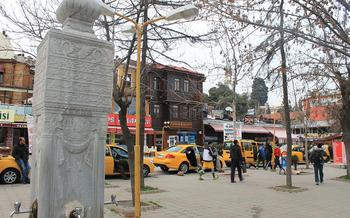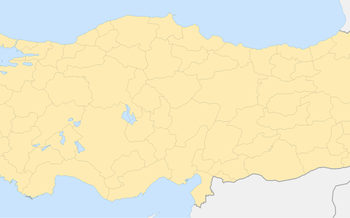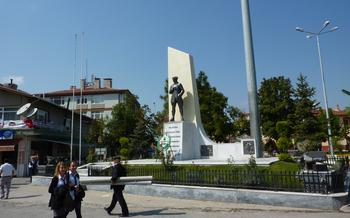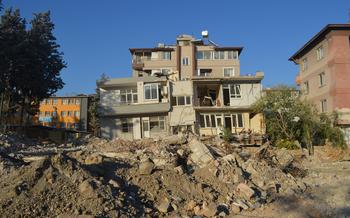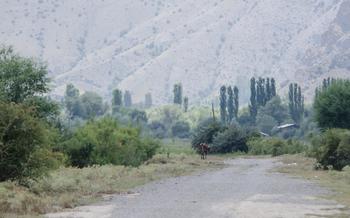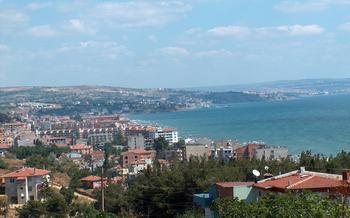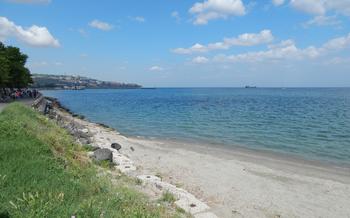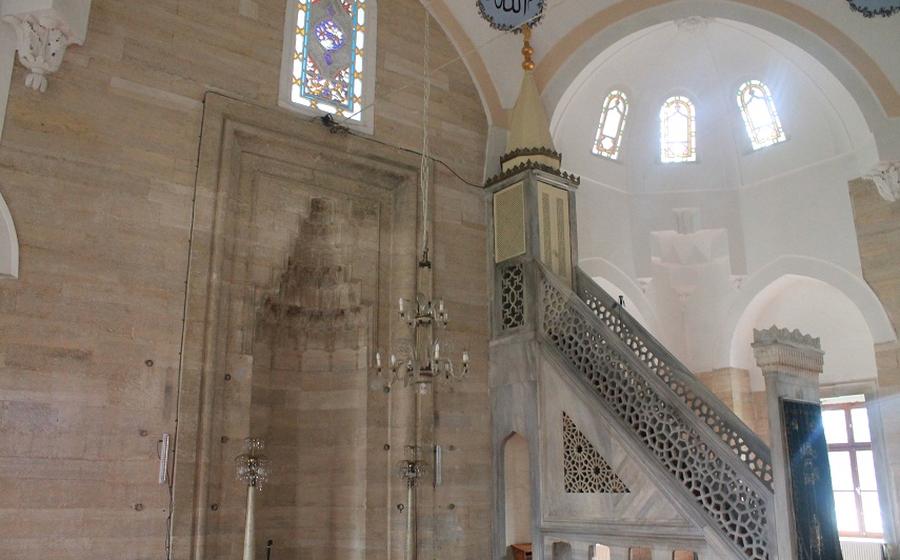
Rüstem Pasha Mosque
- Rüstem Pasha Mosque: A Stunning Masterpiece
- Historical Significance
- Location and Accessibility
- Architectural Highlights
- Intricate Tilework
- Calligraphic Masterpieces
- Prayer Hall Serenity
- Courtyard and Ablution Fountain
- Historical Context
- Nearby Attractions
- Local Cuisine Delights
- Shopping for Souvenirs
- Practical Tips for Visitors
- Insider Tip: Hidden Gem
Rüstem Pasha Mosque: A Stunning Masterpiece
The Rüstem Pasha Mosque, situated in the heart of Tekirdağ, stands as a testament to the grandeur and artistry of Ottoman architecture. Built in the 16th century during the reign of Suleiman the Magnificent, this magnificent mosque is attributed to the renowned architect Mimar Sinan, who left an indelible mark on Islamic architecture with his innovative designs and engineering prowess. The mosque, named after Rüstem Pasha, the Grand Vizier of the Ottoman Empire, is not only a place of worship but also a masterpiece of artistic expression, showcasing intricate tilework, elegant calligraphy, and harmonious architectural elements.
Historical Significance
The Rüstem Pasha Mosque is a testament to the grandeur and power of the Ottoman Empire during the reign of Suleiman the Magnificent. Commissioned by Rüstem Pasha, the Grand Vizier, the mosque was completed in 1554 and served as a symbol of Ottoman prosperity and influence.
Rüstem Pasha, a prominent figure in the Ottoman court, was a trusted advisor and son-in-law to Suleiman the Magnificent. His contributions to the empire were significant, and the construction of the mosque was seen as a reflection of his status and authority.
The mosque's location in Tekirdağ, a strategically important city on the Marmara Sea, further emphasized its symbolic significance. Tekirdağ served as a gateway to the Balkans and a vital center for trade and commerce. The presence of such an impressive mosque in the city demonstrated the Ottoman Empire's control over the region and its commitment to Islamic architecture and culture.
Over the centuries, the Rüstem Pasha Mosque has undergone several renovations and restoration efforts to maintain its architectural integrity and historical significance. These efforts have ensured that the mosque continues to stand as a testament to the Ottoman Empire's rich architectural heritage and its enduring legacy in Turkey.
Location and Accessibility
The Rüstem Pasha Mosque is situated in the heart of Tekirdağ, overlooking the Marmara Sea. Its exact address is Rüstem Paşa Mahallesi, Fatih Sultan Mehmet Cad. No:37, 59000 Tekirdağ Merkez/Tekirdağ. The mosque is conveniently located within walking distance from other notable attractions in the city, such as the Tekirdağ Museum and the historical Tekirdağ Clock Tower.
To reach the mosque, visitors can take advantage of the city's public transportation system. Several bus lines stop nearby, including the Tekirdağ-Çorlu line and the Tekirdağ-Hayrabolu line. Alternatively, taxis are readily available and offer a convenient option for those who prefer a direct ride to the mosque.
The mosque is open to visitors daily from 9 am to 6 pm, with extended hours during the summer months. It is recommended to visit during the early morning or late afternoon hours to avoid the midday heat and crowds. The tranquil atmosphere during these times provides an opportunity for visitors to fully appreciate the mosque's serene beauty and intricate details.
Architectural Highlights
The Rüstem Pasha Mosque boasts a blend of architectural features that showcase the grandeur and artistry of Ottoman architecture. Its exterior facade is adorned with intricate stone carvings, geometric patterns, and elegant calligraphy, creating a visually captivating entrance. The mosque's central dome, a prominent landmark in Tekirdağ's skyline, is supported by four slender minarets, each adorned with intricate tilework and delicate balconies. The interior layout is equally impressive, with a spacious prayer hall featuring a high ceiling and elegant arches. The courtyard, a serene space for ablution and contemplation, is centered around an ornate ablution fountain, surrounded by lush greenery and decorative elements.
Intricate Tilework
Tilework has a rich history in Turkish architecture, dating back to the Seljuk era. In the Rüstem Pasha Mosque, the tilework is particularly exquisite, featuring intricate designs and patterns that adorn the walls, mihrab, and minbar. Geometric motifs, floral patterns, and calligraphic inscriptions create a vibrant and harmonious visual effect. The tiles are arranged in a way that emphasizes the architectural features of the mosque, highlighting the domes, arches, and niches.
The symbolism and significance of the tilework are profound. Geometric patterns represent the order and harmony of the universe, while floral motifs symbolize the beauty and transience of life. Calligraphic inscriptions include verses from the Quran and hadiths, reminding visitors of the spiritual significance of the mosque. The tiles were meticulously crafted by skilled artisans using traditional techniques that have been passed down through generations.
Calligraphic Masterpieces
Calligraphy holds a revered position in Islamic art, serving as a sacred form of expression. In the Rüstem Pasha Mosque, this artistry shines through in the inscriptions adorning its walls and mihrab. Verses from the Quran and hadiths, beautifully rendered in intricate styles, elevate the mosque's spiritual ambiance.
The calligraphers who graced the mosque's interior with their artistry were masters of their craft, renowned for their exquisite techniques and styles. Their work reflects a deep understanding of the Quranic text, capturing its essence and conveying its messages with utmost reverence.
The styles of calligraphy employed in the mosque range from the elegant Thuluth script, known for its elongated horizontal strokes, to the fluid Naskh script, characterized by its rounded letters and graceful curves. Each style adds a unique dimension to the mosque's calligraphic repertoire, showcasing the versatility and mastery of the calligraphers.
The inscriptions in the Rüstem Pasha Mosque not only serve as decorative elements but also as reminders of the divine messages that form the foundation of the Islamic faith. They invite visitors to contemplate the words of the Quran, seeking guidance, inspiration, and a deeper connection with the Almighty.
Prayer Hall Serenity
Beyond its architectural grandeur, the Rüstem Pasha Mosque offers a serene sanctuary for prayer and contemplation. The spacious prayer hall exudes a tranquil atmosphere, inviting worshippers to connect with their faith in a peaceful environment. The elaborate mihrab, a niche indicating the direction of Mecca, and the minbar, a pulpit for delivering sermons, are adorned with intricate carvings and calligraphy, adding to the sacred ambiance.
The soft glow of natural light filtering through the stained-glass windows casts a warm and serene aura upon the carpeted floor, creating a conducive space for contemplation and reflection. The acoustics of the hall are meticulously designed to enhance the recitation of prayers and the melodious call to prayer, ensuring a harmonious and immersive experience for worshippers.
Visitors to the prayer hall are encouraged to observe proper etiquette, including dressing modestly and maintaining a respectful demeanor. While photography is permitted, it is essential to be mindful of the sanctity of the space and avoid disturbing worshippers. Respectful silence and contemplation are encouraged, allowing visitors to fully immerse themselves in the spiritual atmosphere of this sacred sanctuary.
Courtyard and Ablution Fountain
Ablution, the ritual washing before prayers, holds great significance in Islamic rituals. The courtyard of the Rüstem Pasha Mosque features an elaborate ablution fountain, known as a şadırvan, located in the center. This stunning fountain is not just a functional element but also a decorative masterpiece.
The şadırvan is octagonal in shape, with eight spouts pouring water into a large basin. The water spouts are intricately carved with floral and geometric patterns, reflecting the mosque's overall architectural style. The fountain's basin is adorned with colorful tiles, creating a vibrant and eye-catching display.
The courtyard itself is a serene and tranquil space, providing a calming atmosphere for visitors to perform their ablutions before entering the prayer hall. The courtyard is surrounded by a colonnade, offering shade and protection from the elements. The floor is paved with marble, adding to the overall grandeur and elegance of the mosque.
The ablution fountain and courtyard serve as a reminder of the importance of cleanliness and purity in Islamic traditions. They are also a testament to the architectural ingenuity and artistic prowess of the Ottoman Empire, blending functionality with aesthetics in a harmonious manner.
Historical Context
Tekirdağ has a rich and diverse history, dating back to the ancient Greeks and Romans who established settlements in the region. During the Ottoman Empire, Tekirdağ became a significant city due to its strategic location on the Black Sea coast. It served as an important port and trading center, connecting the empire to the Black Sea region and beyond. The city's proximity to Istanbul, the capital of the Ottoman Empire, also contributed to its importance. Tekirdağ was home to a diverse population, including Turks, Greeks, Armenians, and Jews, who contributed to the city's cultural and economic development. Throughout its history, Tekirdağ has witnessed numerous historical events, including battles, conquests, and periods of prosperity. Today, the city is a vibrant blend of its rich past and modern influences, offering visitors a glimpse into Turkey's fascinating history and culture.
Nearby Attractions
Beyond the Rüstem Pasha Mosque, Tekirdağ offers a wealth of historical, cultural, and natural attractions. History buffs can delve into the past at the Tekirdağ Museum, which showcases artifacts and exhibits from the region's rich history. The nearby Tekirdağ Castle, a well-preserved Byzantine fortress, offers stunning panoramic views of the city and the surrounding countryside.
For nature enthusiasts, the Tekirdağ Nature Park, located just a short drive from the city center, provides a tranquil oasis with hiking trails, picnic areas, and a variety of wildlife. The park is home to diverse flora and fauna, making it a popular spot for birdwatching and nature photography.
Shopaholics can indulge in retail therapy at the Tekirdağ Bazaar, a vibrant marketplace where vendors sell everything from traditional handicrafts and souvenirs to fresh produce and local delicacies. Bargaining is expected and part of the fun, so be prepared to haggle for the best prices.
After a day of exploring, satisfy your taste buds with a culinary adventure in Tekirdağ. The city's restaurants offer a range of dining options, from traditional Turkish cuisine to international fare. Don't miss the chance to sample local specialties such as Tekirdağ köfte (meatballs), Tekirdağ pilavı (rice pilaf), and the region's famous wines.
Local Cuisine Delights
Indulge in the tantalizing flavors of Tekirdağ's culinary scene. The region offers a delectable array of dishes that reflect its rich history and cultural influences. Savor the succulent Tekirdağ köftesi, meatballs prepared with a unique blend of spices and herbs. Don't miss the opportunity to relish the freshly caught fish, grilled to perfection and served with a tangy lemon sauce. For a taste of traditional Turkish cuisine, try the hearty keşkek, a dish made from shredded wheat, meat, and chickpeas. Vegetarians will delight in the variety of meze (small plates) featuring grilled vegetables, stuffed grape leaves, and creamy hummus. To satisfy your sweet tooth, indulge in the delectable Tekirdağ sütlaç, a creamy rice pudding topped with cinnamon. Whether you dine at a traditional Turkish restaurant or a modern eatery, Tekirdağ's cuisine is sure to tantalize your taste buds and leave you craving for more.
Shopping for Souvenirs
Tekirdağ offers a treasure trove of unique souvenirs and handicrafts that capture the essence of the region. Immerse yourself in the vibrant local markets and bazaars, where you can find an array of handmade goods, from intricate carpets and pottery to traditional clothing and jewelry. Bargaining is a common practice, so don't hesitate to engage in friendly negotiations with the vendors.
Support local artisans and businesses by purchasing their creations, ensuring the preservation of traditional crafts and techniques. Whether you seek a meaningful gift for loved ones back home or a special memento to commemorate your visit, Tekirdağ's markets offer an unforgettable shopping experience.
Practical Tips for Visitors
Visiting the Rüstem Pasha Mosque is a rewarding experience, but there are some practical tips to enhance your visit:
-
Accessibility: The mosque is wheelchair accessible, with ramps and elevators providing easy access to all areas.
-
Guided Tours: Guided tours are available in multiple languages, offering insights into the mosque's history, architecture, and significance.
-
Audio Guides: Audio guides are also available for self-guided tours, providing detailed information at your own pace.
-
Families with Young Children: The mosque welcomes families, but it's essential to ensure that children are respectful and mindful of the sacred space.
Remember that the Rüstem Pasha Mosque is an active place of worship, so it's important to be respectful of worshippers and maintain silence during prayer times. By following these simple tips, you can fully appreciate the beauty and significance of this magnificent mosque.
Insider Tip: Hidden Gem
Amidst the bustling streets of Tekirdağ, nestled just a short stroll from the Rüstem Pasha Mosque, lies a hidden gem waiting to be discovered. As you exit the mosque's courtyard, turn left and follow the narrow cobblestone path that meanders alongside the mosque's exterior wall. This path leads to a secluded terrace, overlooking the tranquil waters of the Marmara Sea.
Here, you can escape the crowds and immerse yourself in the serenity of the surroundings. The terrace offers a breathtaking panoramic view of the mosque's magnificent dome and minarets, framed against the shimmering backdrop of the sea. As the sun dips below the horizon, the sky transforms into a canvas of vibrant hues, casting a magical glow upon the mosque and the surrounding cityscape.
This hidden gem is the perfect spot to capture stunning photographs of the mosque, especially during the golden hours of sunrise and sunset. It also provides a peaceful ambiance for quiet contemplation and reflection, allowing you to fully appreciate the beauty and tranquility of this architectural masterpiece.
So, after exploring the wonders of the Rüstem Pasha Mosque, take a moment to venture off the beaten path and discover this secret oasis. It's a hidden gem that will leave you with lasting memories of your visit to Tekirdağ.

